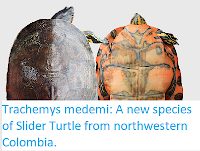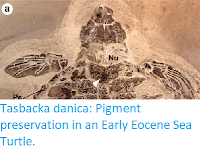Mud Turtles, Kinosternon spp., are small freshwater Turtles found throughout the Americas. They reach their maximum diversity in Mexico, where there are currently seventeen described species, compared to only three in the whole of South America. Unfortunately, despite Turtles being one of the most endangered groups of Tetrapod Vertebrates, they have often been overlooked in surveys of Vertebrates in Mexico, which have concentrated on other groups such as Mammals, Birds and Amphibians, with some parts of the country having almost no records of Turtle populations.
In a paper published in the journal Chelonian Conservation and Biology in June 2018, Marco López-Luna of the División Académica de Ciencias Biolôgicas at the Universidad Juárez Autónoma de Tabasco, Fabio Cupul-Magña and Armando Escobedo-Galván of the Centro Universitario de la Costa at the Universidad de Guadalajara, Adriana González-Hernández and Eric Centenero-Alcalá of the Colección Nacional de Anfibios y Reptiles at the Ciudad Universitaria de México, Judith Rangel-Mendoza, also of the División Académica de Ciencias Biolôgicas at the Universidad Juárez Autónoma de Tabasco, Mariana Ramírez-Ramírez of the División de Ciencias Naturales y Exactas at the Universidad de Guanajuato, and Erasmo Cazares-Hernández of the Instituto Tecnológico Superior de Zongolica, describe a new species of Mud Turtle from the area around the city of Puerto Vallarta in Jalisco State, Mexico.
The new species is named Kinosternon vogti, in honour of Richard Vogt of the National Institute of Amazonian Research, for his work on the freshwater Turtles of the Americas, and mentoring of many younger scientists. The species is described from a series of specimens collected from artificial and disturbed waterways around the city of Puerto Vallarta, its natural habitat is unclear. The species is small for the genus, with the largest known specimen measuring only 101.5 mm in length. The shell of these Turtles is olive-brown with black rims to the scutes (individual plates of the shell) and an orange or yellow underside, the head and limbs are brown and lighter below. The tail is prehensile with a clawed tip.
Kinosternon vogti. (A) Dorsal view. (B) Ventral view. Black line represents 10 mm. Marco López-Luna in López-Luna et al. (2018).
See also...
Follow
Sciency Thoughts on Facebook.







